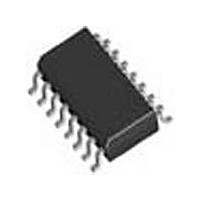LTC1063CS#PBF Linear Technology, LTC1063CS#PBF Datasheet - Page 10

LTC1063CS#PBF
Manufacturer Part Number
LTC1063CS#PBF
Description
Manufacturer
Linear Technology
Datasheet
1.LTC1063CSPBF.pdf
(16 pages)
Specifications of LTC1063CS#PBF
Architecture
Switched Capacitor
Order Filter (max)
5th
Single Supply Voltage (typ)
5/9/12/15V
Dual Supply Voltage (typ)
±3/±5V
Power Supply Requirement
Single/Dual
Single Supply Voltage (min)
4.75V
Single Supply Voltage (max)
16V
Dual Supply Voltage (min)
±2.375V
Dual Supply Voltage (max)
±8V
Operating Temperature (min)
-40C
Operating Temperature (max)
85C
Filter Type
Low Pass Filter
Lead Free Status / RoHS Status
Compliant
Available stocks
Company
Part Number
Manufacturer
Quantity
Price
APPLICATIO S I FOR ATIO
A 4pF parasitic capacitance is assumed in parallel with the
external 10pF capacitor. A ±1% clock frequency variation
from device to device can be expected. The 2MHz clock
frequency designed above will typically drift to 1.74MHz at
70°C (Figure 7).
The internal clock of the LTC1063 can be overridden by an
external clock provided that the external clock source can
drive the timing capacitor, C, which is connected from the
clock input pin to ground.
Output Offset
The DC output offset of the LTC1063 is trimmed to
typically less than ±1mV . The trimming is done at V
±5V. To obtain optimum DC offset performance, appropri-
ate PC layout techniques should be used and the filter IC
should be soldered to the PC board. A socket will degrade
the output DC offset by typically 1mV. The output DC offset
is sensitive to the coupling of the clock output pin 4 (N
package) to the negative power supply pin 3 (N package).
The negative supply pin should be well decoupled. When
the surface mount package is used, all the unused pins
should be grounded.
When the power supplies are fixed, the output DC offset
should not change by more than ±100µV over 10Hz to
1MHz clock frequency variation. When the filter clock
frequency is fixed, the output DC offset will typically
change by – 4mV (2mV) when the power supply varies
from ±5V to ±7.5V (±2.5V). See Typical Performance
Characteristics.
LTC1063
10
0.80
0.75
0.70
0.65
0.60
0.55
0.50
0.45
0.40
0.5
1.0
U
V
S
Figure 7. f
CLOCK FREQUENCY (MHz)
= ±2.5V
1.5
U
V
S
= ±7.5V
CLK
2.0
V
vs K
S
= ±5V
W
f
C = 10pF
T
CLK
A
= 70°C
2.5
= K/RC
1063 F07
3.0
U
S
=
Common Mode Rejection Ratio
The common mode rejection ratio is defined as the change
of the output DC offset with respect to the DC change of the
input voltage applied to the filter.
Table 3 illustrates the common mode rejection for three
power supplies and three temperatures. The common
mode rejection improves if the output offset is adjusted to
approximately 0V. The output offset can be adjusted via
pin 8 (N package) (see Typical Applications).
Table 3. CMRR Data, f
POWER SUPPLY
±2.5V
±5V
±7.5V
The above data is valid for clock frequencies up to 800kHz, 900kHz, 1MHz, for
V
Clock Feedthrough
Clock feedthrough is defined as the RMS value of the clock
frequency and its harmonics which are present at the
filter’s output pin. The clock feedthrough is tested with the
filter input grounded and it depends on the quality of the
PC board layout and power supply decoupling. Any para-
sitic switching transients, during the rise and fall of the
incoming clock, are not part of the clock feedthrough
specifications; their amplitude strongly depends on scope
probing techniques as well as ground quality and power
supply bypassing. For a power supply V
feedthrough of the LTC1063 is 50µV
the clock feedthrough approaches 75µV
shows a typical scope photo of the LTC1063 output pin
when the input pin is grounded. The filter cutoff frequency
was 1kHz, while scope bandwidth was chosen to be 1MHz
such as switching transients above the 100kHz clock
frequency will show.
Wideband Noise
The wideband noise of the filter is the RMS value of the
device’s output noise spectral density. The wideband
noise data is used to determine the operating signal-to-
S
= ±2.5V, ±5V, ±7.5V respectively.
CMRR = 20log (∆V
±1.8V
∆V
±4V
±6V
IN
CLK
OS OUT
– 40°C
= 100kHz
76dB
74dB
70dB
/∆V
25°C
78dB
79dB
72dB
IN
)(dB)
RMS
85°C
76dB
75dB
74dB
S
; for V
= ±5V, the clock
RMS
(V
. Figure 8
S
OS
= ±7.5V,
82dB
76dB
25°C
85dB
Nulled)
1063fa













